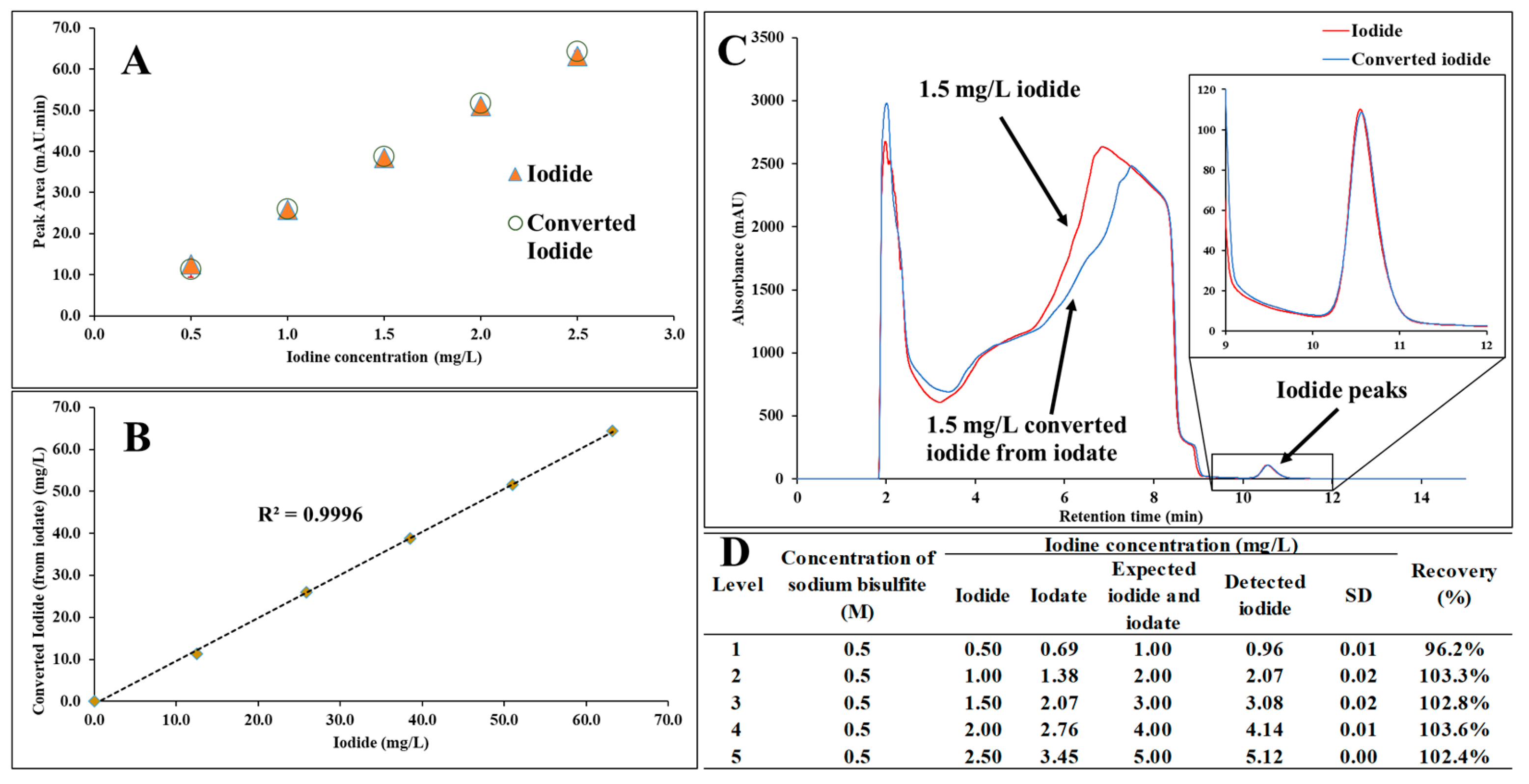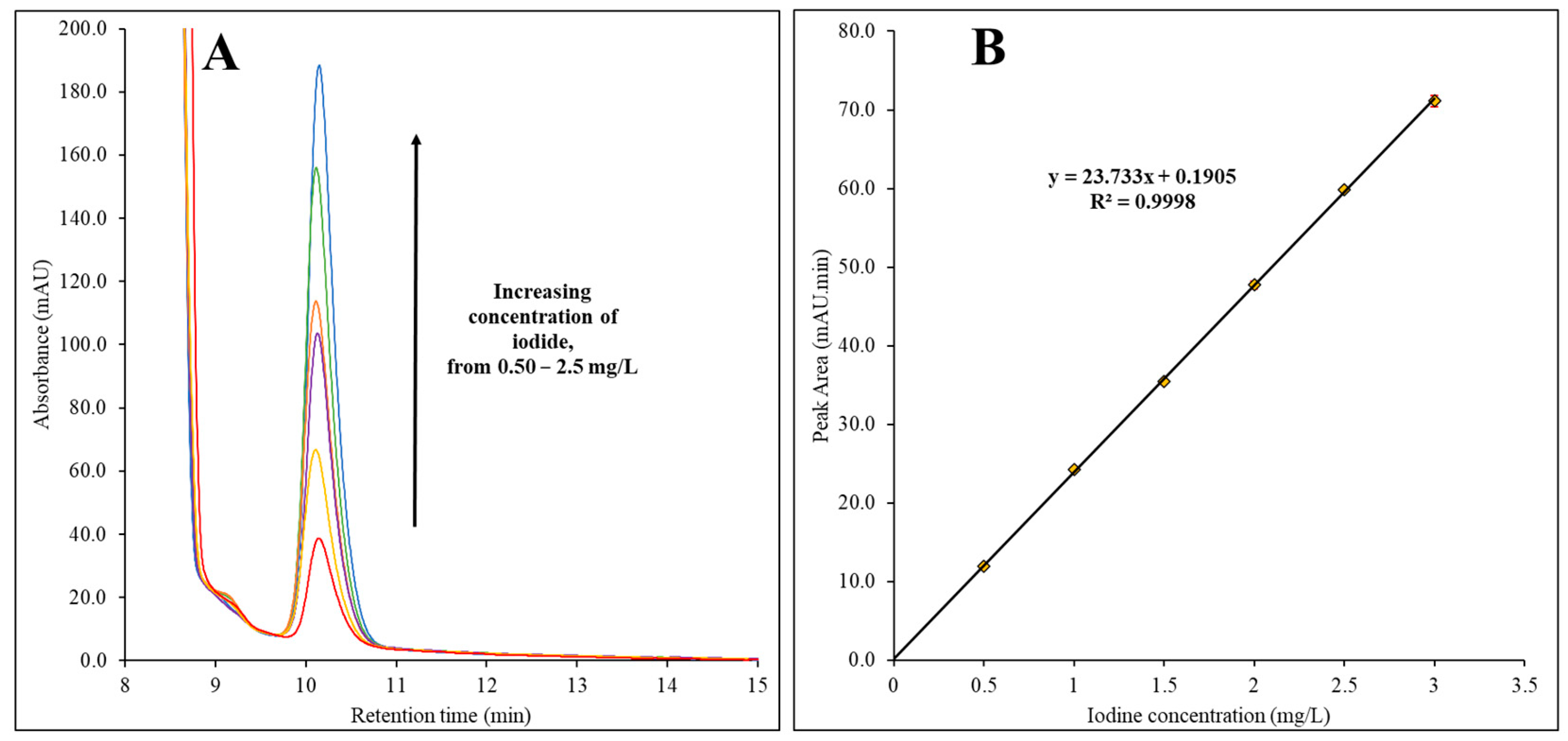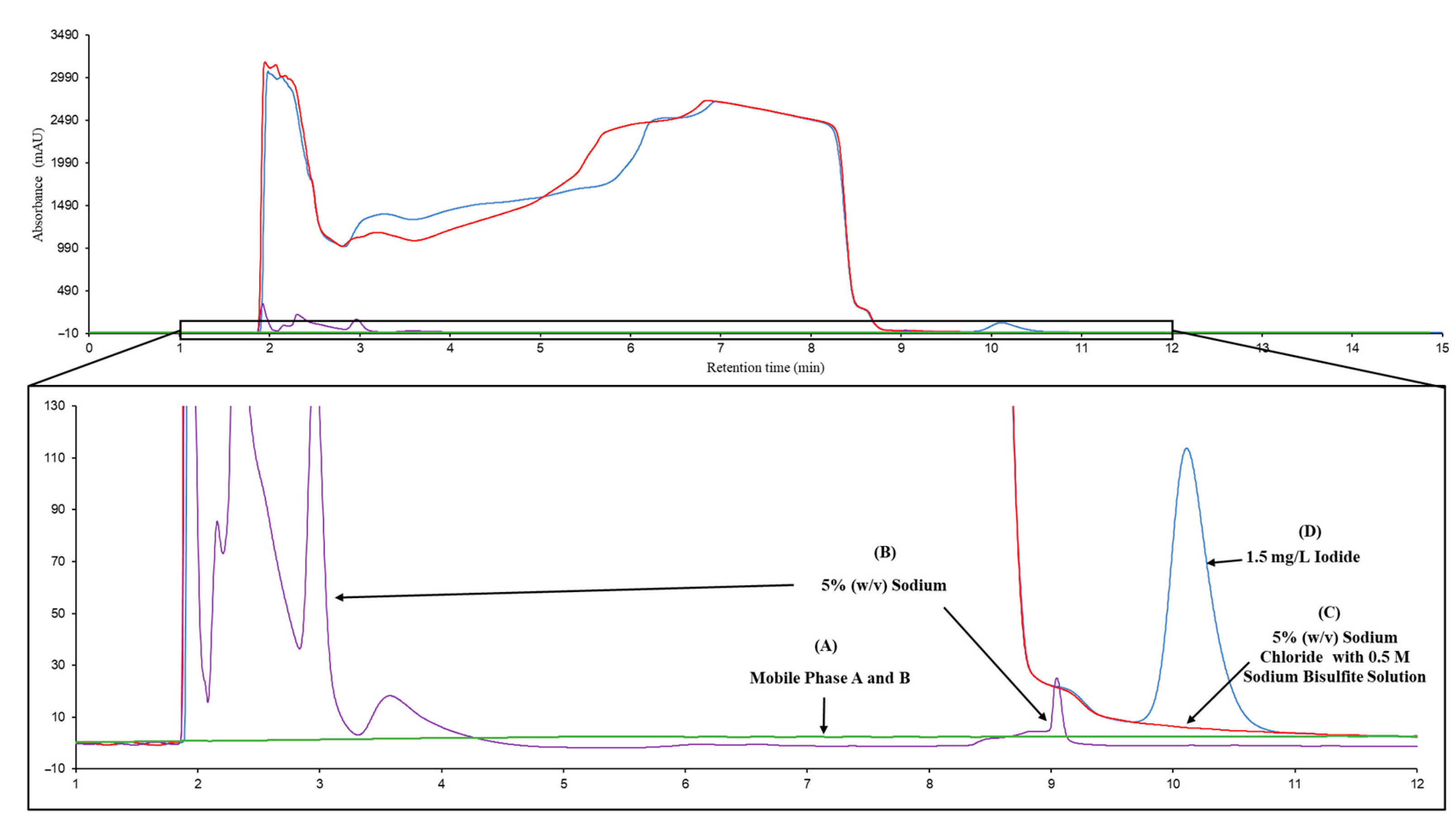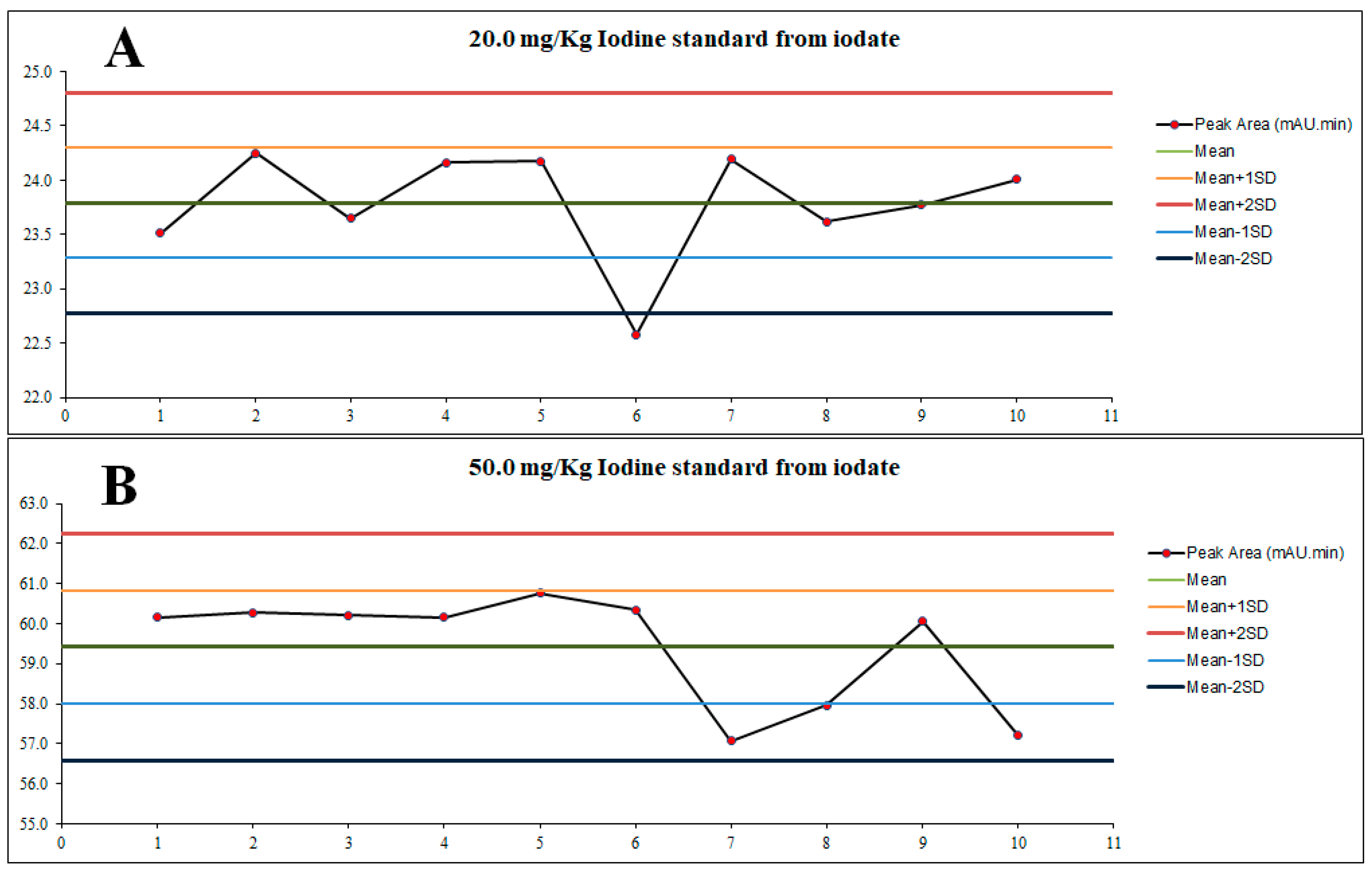Protocol for the Determination of Total Iodine in Iodized Table Salts Using Ultra-High-Performance Liquid Chromatography
Abstract
1. Introduction
2. Materials and Methods
2.1. Chemicals and Reagents
2.2. Instrumentation
2.3. Procedures
2.3.1. Chromatographic Conditions
2.3.2. Column Flushing
2.3.3. Standard Preparation
2.3.4. Sample Preparation
2.4. Method Validation
2.4.1. Accuracy
2.4.2. Linearity, LOD, and LOQ
2.4.3. Specificity
2.4.4. Precision Repeatability and Intermediate Precision
2.4.5. Robustness
2.5. Sodium Bisulfite Stability Study
2.6. Sample Spike and Recovery
3. Results
3.1. Method Development
3.2. Method Validation
3.2.1. Accuracy
3.2.2. Linearity
3.2.3. Specificity
3.2.4. Precision
3.2.5. Robustness
3.3. Stability Study for Sodium Bisulfite as Reducing Agent
3.4. Sample Spike and Recovery
4. Discussion
5. Conclusions
Author Contributions
Funding
Informed Consent Statement
Data Availability Statement
Acknowledgments
Conflicts of Interest
References
- Zimmermann, M.B.; Jooste, P.L.; Pandav, C.S. Iodine-Deficiency Disorders. Lancet 2008, 372, 1251–1262. [Google Scholar] [CrossRef] [PubMed]
- Zimmermann, M.B. Research on Iodine Deficiency and Goiter in the 19th and Early 20th Centuries. J. Nutr. 2008, 138, 2060–2063. [Google Scholar] [CrossRef] [PubMed]
- Speeckaert, M.M.; Speeckaert, R.; Wierckx, K.; Delanghe, J.R.; Kaufman, J.-M. Value and Pitfalls in Iodine Fortification and Supplementation in the 21st Century. Br. J. Nutr. 2011, 106, 964–973. [Google Scholar] [CrossRef] [PubMed]
- Mannar, M.G.V.; Dunn, J.T. Salt Iodization for the Elimination of Iodine Deficiency; International Council for Control of Iodine Deficiency Disorders: The Hague, The Netherlands, 1995; ISBN 9070785137. [Google Scholar]
- Codling, K.; Rudert, C.; Bégin, F.; Peña-Rosas, J.P. The Legislative Framework for Salt Iodization in Asia and the Pacific and Its Impact on Programme Implementation. Public Health Nutr. 2017, 20, 3008–3018. [Google Scholar] [CrossRef] [PubMed]
- Gorstein, J.L.; Bagriansky, J.; Pearce, E.N.; Kupka, R.; Zimmermann, M.B. Estimating the Health and Economic Benefits of Universal Salt Iodization Programs to Correct Iodine Deficiency Disorders. Thyroid 2020, 30, 1802–1809. [Google Scholar] [CrossRef] [PubMed]
- Chavasit, V.; Malaivongse, P.; Judprasong, K. Study on Stability of Iodine in Iodated Salt by Use of Different Cooking Model Conditions. J. Food Compos. Anal. 2002, 15, 265–276. [Google Scholar] [CrossRef]
- Zimmermann, M.B. The Role of Iodine in Human Growth and Development. Semin. Cell Dev. Biol. 2011, 22, 645–652. [Google Scholar] [CrossRef] [PubMed]
- Chaouki, M.L.; Benmiloud, M. Prevention of Iodine Deficiency Disorders by Oral Administration of Lipiodol during Pregnancy. Eur. J. Endocrinol. 1994, 130, 547–551. [Google Scholar] [CrossRef] [PubMed]
- Zimmermann, M.B. Iodine Deficiency. Endocr. Rev. 2009, 30, 376–408. [Google Scholar] [CrossRef] [PubMed]
- Rasmussen, L.B.; Andersen, S.; Ovesen, L.; Laurberg, P. Iodine Intake and Food Choice. In Comprehensive Handbook of Iodine; Academic Press: Burlington, MA, USA, 2009; pp. 332–337. ISBN 9780123741356. [Google Scholar]
- Yun, A.J.; Doux, J.D. Iodine in the ecosystem. In Comprehensive Handbook of Iodine; Elsevier: Amsterdam, The Netherlands, 2009; pp. 119–123. ISBN 9780123741356. [Google Scholar]
- Falk, H.; Geerling, R.; Hattendorf, B.; Krengel-Rothensee, K.; Schmidt, K.P. Capabilities and Limits of ICP-MS for Direct Determination of Element Traces in Saline Solutions. Fresenius. J. Anal. Chem. 1997, 359, 352–356. [Google Scholar] [CrossRef]
- Flores, E.M.M.; Mello, P.A.; Krzyzaniak, S.R.; Cauduro, V.H.; Picoloto, R.S. Challenges and Trends for Halogen Determination by Inductively Coupled Plasma Mass Spectrometry: A Review. Rapid Commun. Mass Spectrom. 2020, 34, e8727. [Google Scholar] [CrossRef] [PubMed]
- Jennings, W.G.; Majors, R.E.; Kirkland, J.J.; Unger, K.K.; Engelhardt, H.; Schomburg, G.; Pirkle, W.H.; Welch, C.J.; Armstrong, D.W.; Porath, J.O.; et al. History and Developments in Chromatographic Column Technology and Validation to 2001. In Chromatography: A Science of Discovery; Wixom, R.L., Gehrke, C.W., Eds.; John Wiley & Sons, Inc.: Hoboken, NJ, USA, 2010; pp. 199–267. ISBN 978-0-470-28345-5. [Google Scholar]
- Lämmerhofer, M.; Nogueira, R.; Lindner, W. Multi-Modal Applicability of a Reversed-Phase/Weak-Anion Exchange Material in Reversed-Phase, Anion-Exchange, Ion-Exclusion, Hydrophilic Interaction and Hydrophobic Interaction Chromatography Modes. Anal. Bioanal. Chem. 2011, 400, 2517–2530. [Google Scholar] [CrossRef] [PubMed]
- Nogueira, R.; Lämmerhofer, M.; Lindner, W. Alternative High-Performance Liquid Chromatographic Peptide Separation and Purification Concept Using a New Mixed-Mode Reversed-Phase/Weak Anion-Exchange Type Stationary Phase. J. Chromatogr. A 2005, 1089, 158–169. [Google Scholar] [CrossRef] [PubMed]
- Dionex. Determination of Iodide and Iodate in Seawater and Iodized Table Salt by HPLC with UV Detection; Application Note 236; Dionex: Chelmsford, MA, USA, 2009; pp. 1–7. [Google Scholar]
- Rebary, B.; Paul, P.; Ghosh, P.K. Determination of Iodide and Iodate in Edible Salt by Ion Chromatography with Integrated Amperometric Detection. Food Chem. 2010, 123, 529–534. [Google Scholar] [CrossRef]
- Buchberger, W.; Czizsek, B.; Hann, S.; Stingeder, G. Preliminary Comparison of Inductively Coupled Plasma Mass Spectrometry and Electrospray Mass Spectrometry Hyphenated with Ion Chromatography for Trace Analysis of Iodide. J. Anal. At. Spectrom. 2003, 18, 512–514. [Google Scholar] [CrossRef]
- Stärk, H.-J.; Mattusch, J.; Wennrich, R.; Mroczek, A. Investigation of the IC-ICP-MS Determination of Iodine Species with Reference to Sample Digestion Procedures. Fresenius. J. Anal. Chem. 1997, 359, 371–374. [Google Scholar] [CrossRef]
- Pomeranz, Y.; Meloan, C.E. High-performance liquid chromatography and ion chromatography. In Food Analysis; Springer US: Boston, MA, USA, 1994; Volume 6, pp. 324–351. ISBN 978-1-4615-7000-4. [Google Scholar]
- Staby, A.; Jensen, R.H.; Bensch, M.; Hubbuch, J.; Dünweber, D.L.; Krarup, J.; Nielsen, J.; Lund, M.; Kidal, S.; Hansen, T.B.; et al. Comparison of Chromatographic Ion-Exchange Resins. J. Chromatogr. A 2007, 1164, 82–94. [Google Scholar] [CrossRef] [PubMed]
- Martin, B.B.; Martin, D.F.; Martin, B.B.; Feliciano, D.; Acıkara, Ö.B.; Citoglu, G.S.; Özbilgin, S.; Ergene, B.; Amaral, A.C.F. Column Chromatography; InTech Open Access Publisher: Rijeka, Croatia, 2013; ISBN 9789535110743. [Google Scholar]
- Shi, Y.; Zhan, X.; Ma, L.; Li, L.; Li, C. Evaluation of Antioxidants Using Oxidation Reaction Rate Constants. Front. Chem. China 2007, 2, 140–145. [Google Scholar] [CrossRef]
- Reckling, M.; Ahrends, H.; Chen, T.-W.; Eugster, W.; Hadasch, S.; Knapp, S.; Laidig, F.; Linstädter, A.; Macholdt, J.; Piepho, H.-P.; et al. Methods of Yield Stability Analysis in Long-Term Field Experiments. A Review. Agron. Sustain. Dev. 2021, 41, 27. [Google Scholar] [CrossRef]




| Iodine Concentration (mg/L) | Found (mg/L) | SD | Recovery (%) | Mean Recovery (%) | RSD (%) |
|---|---|---|---|---|---|
| 1.0 | 1.00 | 0.00 | 100.3% | 100.2% | 0.4% |
| 1.00 | 100.5% | ||||
| 1.00 | 99.8% | ||||
| 1.5 | 1.48 | 0.01 | 98.9% | 99.4% | 0.4% |
| 1.49 | 99.6% | ||||
| 1.49 | 99.6% | ||||
| 2.0 | 1.99 | 0.01 | 99.6% | 99.8% | 0.3% |
| 2.00 | 100.1% | ||||
| 2.00 | 99.8% |
| Replicate | Iodine Concentration (mg/L) | |||||||||||||||||
|---|---|---|---|---|---|---|---|---|---|---|---|---|---|---|---|---|---|---|
| 1.0 | 1.5 | 2.0 | ||||||||||||||||
| DAY 1 | DAY 2 | DAY 1 | DAY 2 | DAY 1 | DAY 2 | |||||||||||||
| Mean | SD | RSD (%) | Mean | SD | RSD (%) | Mean | SD | RSD (%) | Mean | SD | RSD (%) | Mean | SD | RSD (%) | Mean | SD | RSD (%) | |
| 1 (n = 7) | 1.01 | 0.005 | 0.5% | 0.98 | 0.009 | 0.9% | 1.49 | 0.009 | 0.6% | 1.49 | 0.008 | 0.5% | 2.00 | 0.014 | 0.7% | 1.98 | 0.008 | 0.4% |
| 2 (n = 7) | 0.99 | 0.003 | 0.3% | 0.95 | 0.013 | 1.4% | 1.47 | 0.007 | 0.5% | 1.41 | 0.042 | 3.0% | 1.96 | 0.006 | 0.3% | 1.79 | 0.098 | 5.5% |
| 3 (n = 7) | 1.01 | 0.003 | 0.3% | 0.89 | 0.024 | 2.7% | 1.44 | 0.008 | 0.5% | 1.28 | 0.088 | 6.8% | 1.96 | 0.006 | 0.3% | 1.87 | 0.056 | 3.0% |
| Average RSD (%) for repeatability | 0.3% | - | 0.5% | - | 0.4% | - | ||||||||||||
| Average RSD (%) for intermediate precision | 1.0% | 2.0% | 1.7% | |||||||||||||||
| Variation | Condition | Retention Time (min) | Peak Area (mAU.min) | Overall RSD (%) | ||||||||
|---|---|---|---|---|---|---|---|---|---|---|---|---|
| 1.0 mg/L Iodine | 1.5 mg/L Iodine | 2.0 mg/L Iodine | ||||||||||
| Mean | SD | RSD (%) | Mean | SD | RSD (%) | Mean | SD | RSD (%) | ||||
| Default method at 30 °C and 0.5 M sodium bisulfite | 9.92 ± 0.06 | 24.22 | 0.10 | 0.4% | 35.41 | 0.00 | 0.0% | 47.72 | 0.53 | 1.1% | 0.5% | |
| Column temperature (°C) | 40 | 9.28 ± 0.11 | 24.11 | 0.15 | 0.6% | 35.15 | 0.84 | 2.4% | 47.49 | 0.25 | 0.5% | 1.2% |
| Sodium bisulfite concentration (M) | 0.25 | 10.02 ± 0.01 | 23.06 | 0.26 | 1.1% | 34.78 | 0.19 | 0.6% | 46.89 | 0.31 | 0.7% | 0.8% |
| Sample ID | Iodine Concentration (mg/kg) (n = 3) | Iodide Spike (mg/kg) | Recovery (%) | Iodate Spike (mg/kg) | Recovery (%) | |||||||
|---|---|---|---|---|---|---|---|---|---|---|---|---|
| Mean | SD | Spiked | Expected | Found | SD | Spiked | Expected * | Found | SD | |||
| S1 | 23.6 | 0.6 | 30.0 | 53.6 | 53.1 | 0.5 | 99.1% | 41.3 | 53.6 | 53.3 | 0.8 | 99.4% |
| S2 | 19.7 | 0.6 | 20.0 | 39.7 | 40.4 | 0.6 | 101.8% | 27.6 | 39.7 | 38.2 | 0.1 | 96.2% |
| S3 | 24.2 | 1.6 | 30.0 | 54.2 | 51.6 | 0.5 | 95.2% | 41.3 | 54.2 | 55.2 | 0.2 | 101.9% |
| S4 | 7.4 | 0.5 | 10.0 | 17.4 | 16.8 | 0.3 | 96.6% | 13.8 | 17.4 | 18.6 | 0.4 | 106.9% |
| S5 | 25.0 | 1.1 | 30.0 | 55.0 | 53.5 | 0.2 | 97.1% | 41.3 | 55.0 | 58.1 | 0.2 | 105.5% |
| S6 | 23.5 | 0.6 | 20.0 | 43.5 | 39.1 | 0.3 | 89.8% | 27.6 | 43.5 | 37.9 | 0.3 | 87.2% |
Disclaimer/Publisher’s Note: The statements, opinions and data contained in all publications are solely those of the individual author(s) and contributor(s) and not of MDPI and/or the editor(s). MDPI and/or the editor(s) disclaim responsibility for any injury to people or property resulting from any ideas, methods, instructions or products referred to in the content. |
© 2025 by the authors. Licensee MDPI, Basel, Switzerland. This article is an open access article distributed under the terms and conditions of the Creative Commons Attribution (CC BY) license (https://creativecommons.org/licenses/by/4.0/).
Share and Cite
Jamilan, M.A.; Abd Rashed, A.; Md Noh, M.F. Protocol for the Determination of Total Iodine in Iodized Table Salts Using Ultra-High-Performance Liquid Chromatography. Chemosensors 2025, 13, 46. https://doi.org/10.3390/chemosensors13020046
Jamilan MA, Abd Rashed A, Md Noh MF. Protocol for the Determination of Total Iodine in Iodized Table Salts Using Ultra-High-Performance Liquid Chromatography. Chemosensors. 2025; 13(2):46. https://doi.org/10.3390/chemosensors13020046
Chicago/Turabian StyleJamilan, Mohd Azerulazree, Aswir Abd Rashed, and Mohd Fairulnizal Md Noh. 2025. "Protocol for the Determination of Total Iodine in Iodized Table Salts Using Ultra-High-Performance Liquid Chromatography" Chemosensors 13, no. 2: 46. https://doi.org/10.3390/chemosensors13020046
APA StyleJamilan, M. A., Abd Rashed, A., & Md Noh, M. F. (2025). Protocol for the Determination of Total Iodine in Iodized Table Salts Using Ultra-High-Performance Liquid Chromatography. Chemosensors, 13(2), 46. https://doi.org/10.3390/chemosensors13020046





